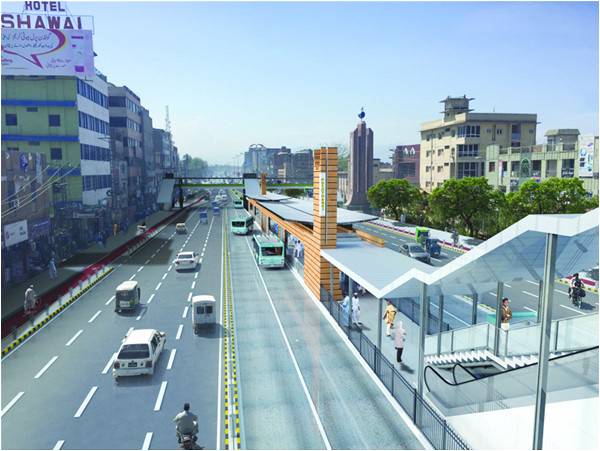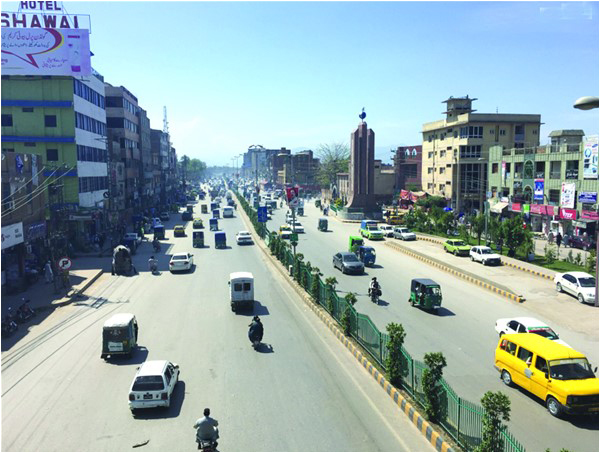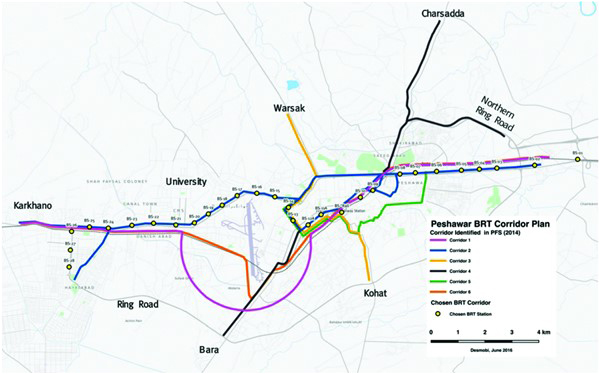
Thirty-year-old Mohammad Adnan’s family has run a clothing business in Peshawar’s Saddar Bazaar for the last 20 years. They have a shop here and one on University Road where they stock clothes from Karachi. They also import from Afghanistan through Torkham. But their once-thriving trade has petered to a trickle, all because of the city’s new Bus Rapid Transit (BRT) system for which work started in November 2017.
The Pakistan Tehreek-i-Insaf-led provincial government of Khyber-Pakhtunkhwa is spending Rs52 billion on the project and considers it one of its most important ones to finish ahead of the elections. There is intense pressure on the chief minister to deliver it on time. The Asian Development Bank has provided over Rs35 billion in a loan and another one is coming from the European Bank (Rs7b).

The BRT system designed by Desain Mobilitas Indonesia (DESMOBI) in association with BRT Planning International & Think Transportation will consist of around 350 air-conditioned buses that will cover a 26-kilometer corridor that starts from Chamkani near the motorway entrance and ends at Shaukat Khanum Cancer Memorial Hospital in Hayatabad. The corridor would have 31 stations and will connect to Peshawar’s outskirts. And while it may be clear that mass transit is needed for the city’s growing population, the road to get there is paved with problems.
Traders such as Adnan say the construction has ruined their business. “Sales dropped from Rs60,000 per day to Rs15,000,” he says. People have just stopped coming because the roads are dug up and the dust pollution fills the air. If they come in their own cars, they are usually stuck in traffic for hours.
Heavy machinery is also blocking thoroughfares such as Railway Road, and portions of Sunehri Masjid Road passing through Saddar have been closed off. The work has effectively frozen life on the city’s main artery and in its central business district from Saddar to University Road.
The association of traders has not been happy. Saddar Bazaar Traders Union president Mujeebur Rehman says the relevant government departments met them several times before the project started. They had promised business would not be affected. “We were told that alternative routes for traffic would be managed and the debris would be picked up immediately,” he said. There is no way to control the dust creating another mess for shopkeepers. “The dust coming inside the shops affects the products.” Of late the administration has started sprinkling water to try and tamp down the dust particulate but that creates its own mess.
Rehman is also worried about the pace of work on the project. He says the government has claimed it would take six months but as far as he can tell, it doesn’t look likely. According to the design documents, the project is slated for completion in March 2021 but the civil works or only the corridor are likely get done in six months.
While many residents believe that BRT will solve their public transport needs in the long run, it is difficult to face the traffic congestion and high levels of pollution in the meantime. The Environment Assessment Plan had clearly warned that the construction could lead to ‘hazardous driving’ conditions in the city. However, the documents also states that the implementation of a traffic management plan during the construction phase would mitigate any possible impact. For its part, the Peshawar Traffic Police had prepared a plan but an official said that they discovered that the narrow roads just couldn’t handle such a heavy load.

An official with the traffic police department, who wished not to be named as he is not authorized to speak to the media, said that the plan could not be properly implemented for several reasons. First, there are no proper alternative routes from which the entire city can be accessed as the connecting roads with the main thoroughfare are too narrow. “We have the main GT Road and University Road where traffic is always at a peak, and there are no proper other alternative routes where traffic from these roads could be diverted.”
A resident of Abdara Road agreed with this assessment. He felt that the executing agency should have constructed alternative routes before starting work. “Peshawar has such congested roads that if one road is closed, a mess is created in the entire city,” he said.
There is an awareness, at least at the policy level that unless Peshawar gets a mass transit system soon, the city will suffer economically. Other problems will be a degradation of the environment, decreased mobility and long commute times and an uptick in the number of motorcycles as cars are slower.
Right now public transport in Peshawar consists of the Mazda minibus and Bedford buses (41 passenger capacity plus 11 on the roof), the Ford wagon (15), the Suzuki vans (18) and the Qingqi (6). Average peak hour speeds for cars along GT road are between 15 and 19 km/hour. In the cantonment, cars travel at a slower speed. In areas such as Khyber Bazaar and Saddar area average peak hour speed for car is lower than 10 km/hour, which is quite low.
The Pakistan Tehreek-i-Insaf-led provincial government of Khyber-Pakhtunkhwa is spending Rs52 billion on the project and considers it one of its most important ones to finish ahead of the elections. There is intense pressure on the chief minister to deliver it on time. The Asian Development Bank has provided over Rs35 billion in a loan and another one is coming from the European Bank (Rs7b).

The BRT system designed by Desain Mobilitas Indonesia (DESMOBI) in association with BRT Planning International & Think Transportation will consist of around 350 air-conditioned buses that will cover a 26-kilometer corridor that starts from Chamkani near the motorway entrance and ends at Shaukat Khanum Cancer Memorial Hospital in Hayatabad. The corridor would have 31 stations and will connect to Peshawar’s outskirts. And while it may be clear that mass transit is needed for the city’s growing population, the road to get there is paved with problems.
Traders such as Adnan say the construction has ruined their business. “Sales dropped from Rs60,000 per day to Rs15,000,” he says. People have just stopped coming because the roads are dug up and the dust pollution fills the air. If they come in their own cars, they are usually stuck in traffic for hours.
Heavy machinery is also blocking thoroughfares such as Railway Road, and portions of Sunehri Masjid Road passing through Saddar have been closed off. The work has effectively frozen life on the city’s main artery and in its central business district from Saddar to University Road.
There are no proper alternative routes from which the entire city can be accessed as the connecting roads with the main thoroughfare are too narrow
The association of traders has not been happy. Saddar Bazaar Traders Union president Mujeebur Rehman says the relevant government departments met them several times before the project started. They had promised business would not be affected. “We were told that alternative routes for traffic would be managed and the debris would be picked up immediately,” he said. There is no way to control the dust creating another mess for shopkeepers. “The dust coming inside the shops affects the products.” Of late the administration has started sprinkling water to try and tamp down the dust particulate but that creates its own mess.
Rehman is also worried about the pace of work on the project. He says the government has claimed it would take six months but as far as he can tell, it doesn’t look likely. According to the design documents, the project is slated for completion in March 2021 but the civil works or only the corridor are likely get done in six months.
While many residents believe that BRT will solve their public transport needs in the long run, it is difficult to face the traffic congestion and high levels of pollution in the meantime. The Environment Assessment Plan had clearly warned that the construction could lead to ‘hazardous driving’ conditions in the city. However, the documents also states that the implementation of a traffic management plan during the construction phase would mitigate any possible impact. For its part, the Peshawar Traffic Police had prepared a plan but an official said that they discovered that the narrow roads just couldn’t handle such a heavy load.

An official with the traffic police department, who wished not to be named as he is not authorized to speak to the media, said that the plan could not be properly implemented for several reasons. First, there are no proper alternative routes from which the entire city can be accessed as the connecting roads with the main thoroughfare are too narrow. “We have the main GT Road and University Road where traffic is always at a peak, and there are no proper other alternative routes where traffic from these roads could be diverted.”
A resident of Abdara Road agreed with this assessment. He felt that the executing agency should have constructed alternative routes before starting work. “Peshawar has such congested roads that if one road is closed, a mess is created in the entire city,” he said.
There is an awareness, at least at the policy level that unless Peshawar gets a mass transit system soon, the city will suffer economically. Other problems will be a degradation of the environment, decreased mobility and long commute times and an uptick in the number of motorcycles as cars are slower.
Right now public transport in Peshawar consists of the Mazda minibus and Bedford buses (41 passenger capacity plus 11 on the roof), the Ford wagon (15), the Suzuki vans (18) and the Qingqi (6). Average peak hour speeds for cars along GT road are between 15 and 19 km/hour. In the cantonment, cars travel at a slower speed. In areas such as Khyber Bazaar and Saddar area average peak hour speed for car is lower than 10 km/hour, which is quite low.

